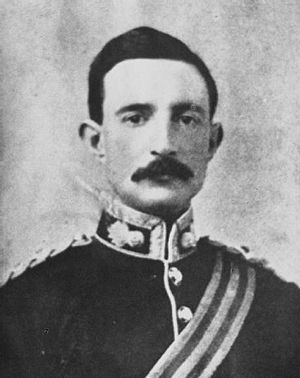Charles FitzClarence facts for kids
Quick facts for kids
Charles FitzClarence
|
|
|---|---|
 |
|
| Born | 8 May 1865 Bishopscourt, County Kildare |
| Died | 12 November 1914 (aged 49) Polygon Wood, Zonnebeke, Belgium |
| Buried |
Menin Gate Memorial
|
| Allegiance | |
| Service/ |
|
| Years of service | 1886–1914 |
| Rank | Brigadier general |
| Unit | Royal Fusiliers Protectorate Regiment Irish Guards |
| Commands held | 1st (Guards) Brigade |
| Battles/wars | Second Boer War World War I † |
| Awards | Victoria Cross |
Brigadier-General Charles FitzClarence was a very brave soldier. He received the VC, which is the highest award for courage in battle. This award is given to soldiers from Britain and Commonwealth countries. He was born on May 8, 1865, and died on November 12, 1914, during World War I.
Contents
Early Life and Army Start
Charles FitzClarence was born in County Kildare, Ireland. His father was Captain George FitzClarence. Charles had a twin brother named Edward. His grandfather was the 1st Earl of Munster. He was an illegitimate son of King William IV of the United Kingdom.
Charles joined the Royal Fusiliers in 1886. Early in his career, he had some illnesses. Because of this, he often worked in office jobs rather than fighting. In 1899, he volunteered for a special role in South Africa. He helped train a group of soldiers called the Protectorate Regiment at Mafeking.
Earning the Victoria Cross
Charles FitzClarence was 34 years old when he earned the Victoria Cross. He was a captain in The Royal Fusiliers during the Second Boer War. He showed amazing bravery in several actions.
Saving an Armoured Train
On October 14, 1899, Captain FitzClarence led his squadron to help an armoured train. The train was in trouble near Mafeking. His soldiers were not fully trained and had never fought before. They were surrounded by many more enemy soldiers.
Captain FitzClarence stayed calm and showed great courage. He inspired his men to fight bravely. He led them so well that they not only saved the train but also defeated the enemy. The enemy lost 50 soldiers, while his group lost only 2. This victory was very important for the soldiers' confidence.
Night Attack at Mafeking
On October 27, 1899, Captain FitzClarence led another daring attack. He took his squadron across open land at night. They used bayonets to attack an enemy trench. There was a fierce hand-to-hand fight inside the trench.
Captain FitzClarence was the first one into the trench. He fought four enemy soldiers with his sword. His men drove the enemy out, causing heavy losses. The British lost 6 soldiers, and Captain FitzClarence was slightly wounded. Major-General Baden-Powell said that without FitzClarence's bravery, these attacks would have failed.
Bravery at Game Tree
On December 26, 1899, Captain FitzClarence showed his courage again. This happened during a battle at Game Tree, near Mafeking. He was wounded severely in both legs during this action.
His fierce fighting style earned him the nickname 'The Demon'. He stayed in South Africa until 1901. Then, he joined the new Irish Guards. He later attended Staff College in 1903. In 1909, he became the commander of the 1st Battalion Irish Guards. He was known for his new ideas in training. Soldiers respected and feared him.
Fighting in The Great War
When World War I began, Charles FitzClarence was promoted. He became a brigadier general. He was given command of the new 29th Brigade.
Leading the 1st Guards' Brigade
On September 27, 1914, he took command of the 1st Guards' Brigade. This brigade was part of the British Expeditionary Force. He led this group until he was killed in action on November 12, 1914.
On October 4, 1914, his brigade was holding trenches near the River Aisne. He ordered a night raid on a German position. This was the first British trench raid of World War I. It was a big success for the British.
The Battle of Ypres
In October, FitzClarence played a key role in the First Battle of Ypres. His brigade faced a huge German attack. On October 27, 1914, about 24,000 German soldiers attacked only 5,000 tired British troops. His soldiers fought incredibly hard. Even though they suffered many losses, the British line held firm.
Sir John French, a top British general, praised this fighting. He called it one of the most important attacks against the British forces at Ypres. FitzClarence was crucial in ordering a vital counter-attack on October 31, 1914. He rallied his troops and led a successful charge. One officer said that FitzClarence "saved the day" with his actions.
Final Battle
On November 11, the Prussian Guard attacked British troops. On the morning of November 12, FitzClarence led a counter-attack. He decided to lead his old regiment himself. Sadly, he was killed during this attack. He was 49 years old.
Sir John French spoke highly of him after his death. He said FitzClarence's loss would be "severely felt." Historians describe FitzClarence as a great example of a British officer. He showed courage, skill, and strong leadership.
He died in Polygon Wood, Zonnebeke, Belgium. He was commanding the 1st (Guards) Brigade at the time. He is the highest-ranking officer listed on the Menin Gate Memorial in Ypres. This memorial remembers soldiers who have no known grave.
His Victoria Cross Medal
You can see Charles FitzClarence's Victoria Cross medal. It is displayed in the Lord Ashcroft VC Gallery. This gallery is located in the Imperial War Museum in London.
Family Life
On April 20, 1898, Charles FitzClarence married Violet Spencer-Churchill in Cairo. She was the daughter of Lord Alfred Spencer-Churchill. She was also the granddaughter of the sixth Duke of Marlborough. Charles and Violet had two children:
- Edward Charles FitzClarence, who later became the 6th Earl of Munster.
- Joan Harriet FitzClarence.

